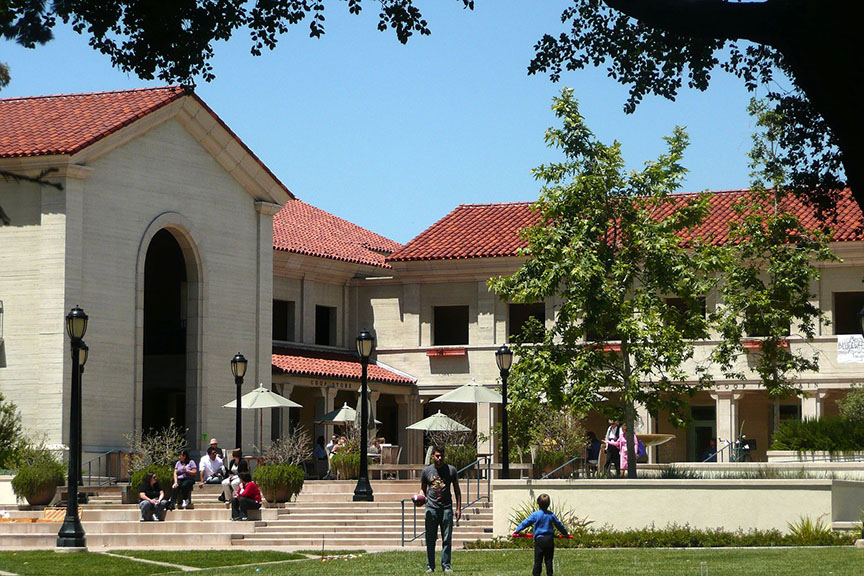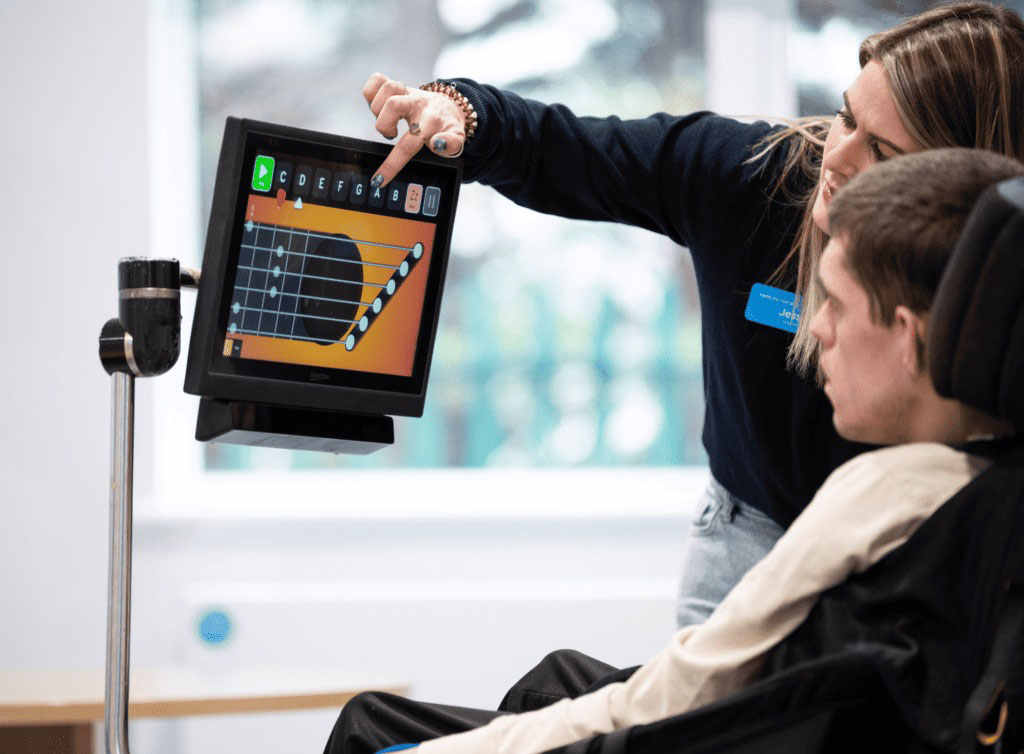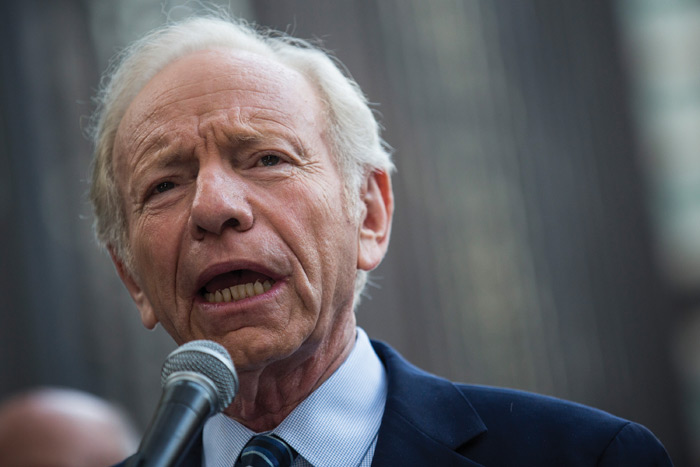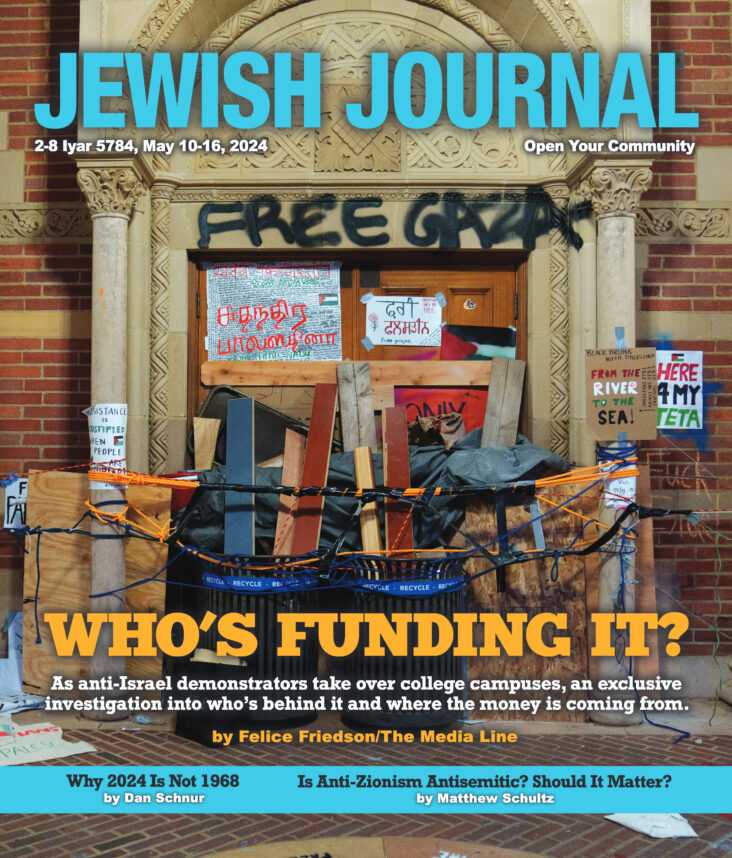Just a few miles south of Lake Arrowhead, in the mountains of the San Bernardino National Forest, sits the small town of Running Springs — its center just a few blocks of touristy gift shops, a hardware store and ski rental outlet, some restaurants, gas stations and motels. It’s the sort of place that feels almost like a Hollywood set for a mountain resort; pine trees cover every undeveloped part of the landscape, many of the storefronts have the rustic look of log cabins, and, on a good day, the high elevation (6,000 feet above sea level) produces the type of fresh, crisp air that’s hard to come by in Los Angeles, just 80 miles west.
And a few turns beyond the town’s center, off Seymour Road, you come to a sudden stop at two huge iron gates. Beyond those gates lie 70 acres of storied property that recently sold for more than $7 million: land first developed by a Hollywood star, later purchased by a scandal-ridden boarding school and, in 2005, bought by Chabad of California, which ran a camp and Jewish retreat there until 2011, when Pacific Mercantile Bank foreclosed upon the property.
After the foreclosure and until last summer, it seemed unimaginable that the Running Springs property would remain in the possession of a Jewish organization. Chabad’s chances of retaining the property were nil, even though it was fighting hard in court to make it difficult for Pacific to sell it. For three years, no other Jewish organization expressed interest or had sufficient capital to place a bid.
The camp at Running Springs was the subject of controversy and wild tales even before Chabad purchased the property in 2005.
Until one did — Bnei Akiva of Los Angeles, the local branch of the international religious Zionist youth movement. Last June, Bnei Akiva launched a $10 million fundraising campaign for the purchase and restoration of the Running Springs property. This by an organization with an annual budget of only $500,000 that was already operating a new three-week summer camp in Malibu — albeit one bursting at the seams.
By September, Bnei Akiva had raised enough money to purchase the property from the bank for $7.1 million. And now the site is bustling every weekday with contractors, inspectors and myriad workers hurrying to ready the campgrounds to open its season in June for the first-ever retreat at the new site, and in July for its summer camp, which will be open to children entering third through 10th grade.
But this is more than just a summer camp story with a happy ending. The camp at Running Springs was the subject of controversy and wild tales even before Chabad purchased the property in 2005. And for the last three years, before Bnei Akiva came in, Chabad’s legal battle with Pacific Mercantile Bank overlapped with another legal battle between Chabad and a Malibu widow whose husband Chabad buried on the camp grounds.
The current scenario — allowing the property to remain in Jewish hands — was unimaginable at this time last year, when it was still mired in an acrimonious battle that, interviews and court documents suggest, was the result of Chabad’s willingness to pursue any legal avenue possible to freeze any sale on the foreclosed property for as long as possible.
But now, as Bnei Akiva’s ambitious vision for Running Springs is taking shape, a place with a madcap history of burials, bankruptcy and dreams unrealized could end up becoming one of L.A. Jewry’s most valuable assets, religiously and financially.
 Facilities left to deteriorate when Chabad left the campground at Running Springs include basketball and tennis courts as well as swing sets.
Facilities left to deteriorate when Chabad left the campground at Running Springs include basketball and tennis courts as well as swing sets.
A few hundred feet inside the gates of the David Oved Retreat Center, just to the left of the camp’s main road and across from its main administrative office, a small patch of land is covered with dirt, stones and leaves. A chain-link fence stands on one side of the patch, and a wire attached to a few thin, green poles partially encloses some of the area.
Today, this tiny piece of the larger property looks totally unremarkable, but a little background knowledge reveals that the slightly elevated mound of dirt represents a significant piece of the convoluted story of the place. It’s where the bodies of Steven Panikoff and Edward Coe were once buried — until Pacific Mercantile Bank had them disinterred and relocated in 2012, not long after foreclosing on the property.
Before Panikoff died on Nov. 24, 2006, at the age of 59, he made plans to be buried on a peaceful, isolated plot in the San Bernardino Mountains — land that he wanted to become a legacy for his love and support of communal Jewish life.
Weeds consumed the tennis and basketball courts, and the large swimming pool next to the former Edward and Maxine Coe Children’s Center was empty.
He wanted most of all for the land to be an enduring testimony to his decades-long support of Chabad of California, which was established in 1965 by Rabbi Boruch Shlomo Cunin, who still runs the organization.
Panikoff decided in 2004 to make a major gift — although the amount was never disclosed — to Chabad to help the organization purchase the Running Springs site.
Chabad closed on the land in 2005, and renamed it Kiryas Schneerson — Schneerson Town — for the late leader of the Chabad movement. Over the course of six years, Kiryas Schneerson served thousands of local Jews as a summer camp and weekend retreat center, until Pacific Mercantile Bank foreclosed upon the property in 2011 following Chabad’s failure to make its monthly payments.
In January 2009, a little more than two years after Panikoff’s death, and nearly three years before Chabad defaulted on the multimillion-dollar loan, according to a lawsuit filed in Los Angeles Superior Court in 2011 by Coe's wife, Maxine, Coe, who was near death, and Maxine, met in a hospital with Boruch Shlomo Cunin and his son Levi, the co-director of Chabad of Malibu.
Coe's suit ended in a sealed settlement with Chabad of California, so the validity of her accusations cannot be verified. In a phone interview with the Journal, Boruch Cunin declined to discuss any specifics of the case. Coe, now 87, is back living in her Malibu home, which she reclaimed in the settlement. She did not respond to several phone calls from the Journal.
 A property of fame and notoriety
A property of fame and notoriety
In September, a walk around Bnei Akiva’s newly acquired campus — now renamed the David Oved Retreat Center — felt, at times, like a walk into the past. Weeds consumed the tennis and basketball courts, and the large swimming pool next to the former Edward and Maxine Coe Children’s Center was empty. Inside the grand cabin that once served as Chabad’s staff headquarters, a coat of dust covered the wood floors, carpets and bunk beds, awaiting cleaning and restoration by Bnei Akiva’s contractor.
The bedrooms where staffers and guests will sleep were already furnished with chairs, night tables and neatly made beds left by Chabad — despite having been uninhabited for years.
In 1932, Academy Award-winning actor Walter Huston acquired the land and built an opulent three-story cabin there as a getaway from Hollywood. That cabin remains the centerpiece of the campsite, built into a mountain ledge overlooking the San Bernardino National Forest’s descent into Redlands and Yucaipa. Bnei Akiva plans to serve most of its summer camp meals in the lodge’s dining area, will utilize its game room and central lounge for programming, and will open up its 13 guest rooms for retreats.
A 1996 issue of Architectural Digest featuring the property described a workshop next to the cabin where, many decades earlier, Huston “could be found every morning at eight, working with the tools that gave such a smooth order to his day.”
Huston died in 1950, but it wasn’t until 1967 that the Running Springs property was bought by CEDU Educational Services, a company that operated boarding schools for troubled teenagers throughout the West. CEDU’s tenure at Running Springs initiated the site’s history of lawsuits and controversy —– in CEDU’s case, there were allegations of misconduct, neglect and abuse, many of which occurred at the Running Springs site.
In 2012, author James Tipper, who was a student at CEDU in Running Springs from 1982 to 1984, published “The Discarded Ones,” a novel based on a composite of true stories about teenagers’ often-traumatic experiences at CEDU's schools in Running Springs and Idaho. Tipper, who now lives in West Hollywood, said in an interview that the CEDU school was so notorious that when he returned to the property a few years ago to scout it out for his novel, a Scottish rabbi who spotted him kicked him off the site after learning that he went to “that school for crazy people,” Tipper said.
After the controversies surrounding CEDU helped lead to its closure, in 2005, Chabad of California put up $4.3 million to purchase the property, which Boruch Cunin imagined becoming the center of L.A.’s Chabad and Orthodox communal life. In the six years Chabad owned the property, Running Springs was a popular attraction, but a somewhat smaller version of what Bnei Akiva envisions.
Families came year-round on weekends, and hundreds of Jewish campers spent summers there, but the strict separation of boys and girls, and the affiliation with Chabad, may have somewhat limited its appeal to the non-Chabad Orthodox community, and perhaps even more so to the even larger sector of non-Orthodox Jews in Los Angeles, many of whom already are served by well-established interdenominational camps, including Ramah in Ojai, Alonim in Simi Valley, the Wilshire Boulevard Temple Camps and JCA Shalom in Malibu, and the Zionist Habonim Dror-Gilboa near Big Bear.
Losing Running Springs, sort of
Beginning in summer 2011, but accelerating into the fall, troubling signs emerged in Chabad’s management of Running Springs. According to Pacific Mercantile Bank, Chabad stopped making its monthly mortgage payments on the property in June 2011. (Late last year, Robert Sjogren, Pacific’s chief operating officer, agreed on behalf of the bank to discuss this history when the bank learned that Chabad’s attorney was speaking with the Journal, even though typically such information about client relations would have remained private.)
In September 2011, the bank filed pre-foreclosure documents on the site, officially putting Chabad of California on notice. Two months after that, it foreclosed, setting off a legal storm in which Chabad, through legal maneuvering, gained five more months, during which its associates stayed on the property, and years during which the grounds remained uninhabited but nearly impossible for the bank to sell.
Sjogren wrote in response to a list of questions submitted by the Journal that the bank lost more than $2 million on its $8.25 million loan, and that only six months after the loan was issued in December 2007, Chabad “stopped making payments in accordance with the terms of its loan agreement.” He said that between mid-2008 and November 2011, the bank and Chabad attempted to settle, and “when those efforts were exhausted,” the bank filed for foreclosure.
The content of the back-and-forth letters, legal briefs and oral arguments between 2011 and September 2014 suggest Chabad’s strategy was not so much to regain its property (there was little chance of that after default and foreclosure), but rather to hamstring the bank’s ability to sell the grounds to other buyers. On numerous occasions, Simkin wrote to the bank that Chabad would repurchase the Running Springs property for $4 million.
“You hold on until the very end,” Simkin said in an interview in his Century City office in September. “You never know what’s going to happen.” Cunin, in a telephone interview, said he believes that keeping Running Springs “on ice” from 2011 to 2014 helped ensure that it would remain an asset of the Los Angeles Jewish community. He also said the only reason Chabad discontinued its legal push to hold on to the site was because Bnei Akiva was the buyer.
“If this would have been a different group, I would not have stopped,” Cunin said. “There was a purpose holding on all these [years], so it didn’t end up … God knows what it could’ve been.”
It’s not clear from court documents, though, that holding out for another Jewish buyer was Cunin’s strategy from the beginning. The hundreds of pages of court documents and letters sent from Simkin to the bank’s attorneys at The Wolf Firm in Irvine and, later, Prenovost, Normandin, Bergh & Dawe in Santa Ana, suggest instead that Chabad hoped it would keep the property for itself.
The court documents are public, and Simkin shared with the Journal many of his email correspondences with Pacific’s legal counsel.
Dana Ozols, an attorney who worked for The Wolf Firm on the Running Springs case in 2011 and 2012, and now has her own practice in Orange County, briefly discussed the case when reached by telephone.
“We’ve all had weird cases come our way, but this was a particularly strange one,” Ozols said.
After Pacific Mercantile Bank served notice to Chabad on Dec. 6, 2011, to vacate within three days, Chabad refused, prompting the bank to file an unlawful detainer suit — a declaration that Chabad was illegally maintaining control of property that wasn’t theirs. Chabad held firm, and Simkin wrote to attorney Dean at The Wolf Firm warning that the property would cost the bank at least $33,000 per month to maintain, and saying it has “limited sale value,” so would take “many years to find a suitable buyer.” It was a prescient warning, realized at least in part because of Simkin’s and Cunin’s legal tactics. “This will be another anchor around [the bank’s] neck,” Simkin wrote, adding that a battle over the property would bring the bank “immeasurable adverse publicity.”
Alternatively, he continued, “Chabad is willing to compromise and settle all matters.” Chabad, Simkin wrote, was willing either to pay $5,000 in rent per month and have veto power over a sale or it would pay $4 million to purchase the land. The bank turned down both offers, believing the property was worth closer to $7 million, almost exactly the amount it ultimately received from Bnei Akiva in September 2014.
Sjogren told the Journal in September 2014 that Chabad’s purchase offer “was so far below a current appraised value that it was not deemed by the bank to be a reasonable offer that would compel us to engage in negotiations.”
After being evicted by the San Bernardino County sheriff in March 2012, and locked out of Running Springs after a summary judgment ruled in the bank’s favor, Simkin and Chabad worked furiously to make arrangements to collect the massive amounts of personal property still at the site, including chairs, mattresses, bunk beds, tables, industrial kitchen equipment, paintings, a trash compactor and hundreds of other items used to run a sleep-away camp or resort. Pacific set the terms for Chabad to retrieve its property (terms geared toward protecting the bank in the event of a mover getting injured), but Chabad never came to collect, failing to agree with Pacific on the terms.
Over the next several months, until the bank put the property up for auction in October 2012, Chabad and Pacific traded offers on how and when the personal property should be collected. Chabad wanted access to the land for several days; Pacific would grant only one day. The bank also demanded Chabad pay “storage fees” for leaving its personal property in the bank’s possession; Chabad objected. A letter dated April 13, 2012, suggests the bank was highly distrustful of Chabad and was apprehensive about allowing them to re-enter Running Springs.
At an Aug. 28, 2012, hearing in Superior Court in San Bernardino to adjudicate the legal requirements Pacific was placing upon Chabad to remove its personal property, Simkin took issue with the bank’s demand to approve the movers Chabad would use before allowing entry to the property.
“What criteria is the plaintiff going to use to approve? ‘Oh, I don’t like the length of your beard. I don’t like that you look out of shape. I don’t like that you’re whatever,’ ” Simkin said to Garza. “Your honor, I think item No. 5 is another example of the anti-Semitism by this bank.”
The final chapter in the personal property dispute appears finally to have been closed when Pacific Mercantile Bank listed the remaining Chabad property for public sale with an auctioneer in October 2012. An audio recording of the auction provided by Simkin identified one or two Chabad representatives bidding $100, even though the auctioneer announced an opening bid of $33,578 by the bank. The auction closed after a few minutes, and Pacific claimed ownership of the personal property.
Sjogren, the Pacific COO, defended the auction process, arguing that Chabad of California was given the opportunity to collect what it owned and forfeited its ownership by never agreeing to Pacific’s terms. “After a period of time, from a legal standpoint, the uncollected personal property was deemed to have been abandoned,” Sjogren wrote.
For nearly a year after the auction, documents indicate that the legal battle over Running Springs paused until July 2013. The reason for the apparent gap in communication is unclear. Although the property had a live-in caretaker, it was falling apart, with the combination of weeds, heat, cold, precipitation and sunlight slowly decimating the site.
In July, though, a state appeals court helped Chabad’s case by reversing the summary eviction ruling from early 2012.
In its argument to the appeals court, Chabad alleged that the bank had unlawfully evicted Chabad in 2011 by failing to serve its onsite caretaker, Asher Asayag, with an eviction notice. That violation, Chabad argued, would require a trial in order to be resolved and should reverse the summary eviction that kicked out Chabad. The appeals court agreed that the trial court had erred in granting Pacific Mercantile Bank summary judgment in the eviction hearing in early 2012.
Chabad’s victory in this instance created a muddy and confusing legal scenario. It very well could have made it even more difficult for Pacific to sell the grounds because the appeals court’s ruling gave Chabad legal justification in arguing that it was unlawfully evicted from the property.
But at the same time, because Chabad had defaulted on a loan, even if Pacific had not followed proper procedures in evicting the organization, Chabad still had no substantial legal claim to Running Springs.
 Bnei Akiva enters the fray
Bnei Akiva enters the fray
For about two decades, until 2013, Modern Orthodox parents in Los Angeles and throughout the Western United States were severely limited in terms of camping choices for their children, since the closing of an Orthodox camp outside Big Bear. Every option required flying across the country, often to Wisconsin or the East Coast, or even to Toronto, if they wanted their children to attend a Modern Orthodox summer camp.
“I had one child who did not go to sleep-away camp because she didn’t want to get on a plane. It was too far,” said Ruth Berkowitz, a Bnei Akiva board member.
But in June 2013, Bnei Akiva brought Orthodox camping back to Los Angeles with Camp Moshava Malibu, a three-week camp during summer’s final weeks, run on the property of the Shalom Institute’s Camp JCA Shalom. In its first year, Moshava Malibu filled the bunks with nearly 170 campers at a price of about $1,000 per week. In 2014, with some increased capacity, 200 kids attended the camp, mostly from Los Angeles but also from cities such as San Francisco, Denver and Seattle.
In March 2014, Bnei Akiva of Los Angeles learned that Chabad’s former mountain camp property was still up for sale and that the bank was searching for buyers. That information may have not meant much to the organization in previous years, when Bnei Akiva was focused almost exclusively on things such as weekend Shabbat retreats, after-school activities, classes and activities at local synagogues, and leadership programs for high-school students.
Also, Bnei Akiva already had its hands full with the Malibu property it leased for only three weeks per year, and the group was having difficulty raising the money it needed to provide the amount of scholarships it wanted.
But for Berkowitz and fellow board member Jonathan Gerber, both of whom, before Moshava Malibu, flew their kids across the country to attend Orthodox summer camp, the possibility of acquiring this type of asset only 90 miles away was too alluring to ignore.
“The cost of developing raw land into a camp site is somewhere around $25 million,” Gerber said in June, a few weeks after Bnei Akiva announced a $10 million fundraising campaign to finance the purchase and restoration for Running Springs. “Summer camps on the West Coast are typically nonprofit because lands are so expensive. You can’t find a decent piece of property on the West Coast for what you can on the East Coast.”
Rabbi Kenny Pollack, a Los Angeles native and the head of camp for Moshava Malibu, said because the rental costs and the annual practice of rendering the entire kitchen suitably kosher at the Shalom Institute’s site ate up such a large portion of the budget, the camp spent more time raising money to cover its annual deficit than it did fundraising for scholarships.
“This year, we had 15 kids drop out after they had accepted because we couldn’t offer them enough scholarships,” Pollack said. “They said, ‘Rabbi, my kid had a great time [last year], they would love to come back, we just can’t afford it, and you can’t possibly give enough scholarship money.”
Running Springs could become what many believe a vibrant JCC in Los Angeles could be — a site shared by synagogues and schools of different denominations. A communal meeting ground, of sorts.
Ideally, Pollack said, the camp would try to commit to working with any family that wants to register a child for summer camp. But renting in Malibu made that financially impossible. “We can’t run our camp like that or we would be bankrupt,” Pollack said.
“A lot of the school systems in the area start school in the middle of August,” Gerber added, explaining why Moshava Malibu’s three-week operating window in August — after Camp JCA Shalom ends its sessions — limits the camp’s reach. “We only get traditional day schools. We want to grow beyond that.”
The question is: To where? Bnei Akiva envisions making available to the entire Jewish community a year-round retreat center at Running Springs, though it would be especially useful for the Orthodox, who require a strictly kosher kitchen and an eruv for carrying items in public areas on Shabbat. “The Orthodox community wouldn’t use Brandeis-Bardin without turning over the kitchen, which is a big ordeal,” Gerber said. “It’s not plug-and-play.”
Gerber envisions Jewish schools and youth groups using Running Springs for weekend Shabbatons, and synagogues renting it for events such as hosting weekend scholars-in-residence. If this comes to be, Running Springs could become what many believe a vibrant JCC in Los Angeles could be — a site shared by synagogues and schools of different denominations. A communal meeting ground, of sorts.
“If Sinai Temple or Temple Beth Am had an interest in using the facility in aggregate or taking a room or two for families, [they’d be] welcome,” Gerber said, referring to two of the city’s largest Conservative synagogues. “If B’nai David” — a Modern Orthodox synagogue — “wanted to take over the site and have a scholar-in-residence weekend with one particular speaker who may not be appealing to the whole breadth of Orthodoxy, they would be welcomed and encouraged.”
Rabbi Menachem Hecht, Bnei Akiva of Los Angeles’ newly hired and first executive director, said he wants Running Springs to become a meeting point for “Jews across the spectrum” to interact with one another, and added that Bnei Akiva would consider opening the site to non-Jewish groups, as well, “to the degree that it allows us to maximize occupancy and be financially sustainable.”
Hecht wrote in an email that Bnei Akiva of Los Angeles will run its camp and youth programs according to Bnei Akiva’s national and international standards, but that “other groups will be welcome to maintain their own responsible policies in regards to dress and gender separation when running programs on the site.”
“This is set up ultimately for Orthodox groups, but by no means do we mean it to be exclusive for Orthodox groups,” Hecht, 33, said in a telephone interview from Manhattan, where he currently lives with his wife and newborn child. They plan to move to Los Angeles in a few months.
Last summer, before it became clear that Bnei Akiva would be able to raise enough money to buy Running Springs, and before Chabad took issue with Pacific Mercantile Bank for trying to sell the land prior to settling its dispute with Chabad, Gerber already spoke of Running Springs as a “Jewish asset” that the community should not let get away.
“It would be no different than boarding up a shul and selling it to a church,” he said.
From July until the sale to Bnei Akiva became final in September, Chabad objected to both the bank and Bnei Akiva when it learned a sale was in the works despite Chabad’s continued legal attempts to repurchase the land, recover its personal property or reach a settlement to resolve both of those issues.
Nevertheless, on Sept. 12, 2014, Bnei Akiva closed on the site for $7.1 million, and Cunin confirmed to the Journal that Chabad would not involve Bnei Akiva in any lawsuit regarding the real or personal property.
“We really love Bnei Akiva, and I think the feeling is quite mutual,” Cunin said. “Our battle was with the bank and still is.”
Coming in summer 2015
“The property is not the pristine, well-run property that was foreclosed upon. It’s dilapidated,” Gerber said in September.
At two separate visits to the site — one in June and one in October — it was clear the property needed an immense amount of cleanup and restoration before its launch date on June 14.
Chabad’s belongings remained strewn around offices and closets in the main lodge. Board games, papers, kitchen appliances and a bevy of other items Chabad left behind had become Bnei Akiva’s property, for better or worse. And, because the site had barely been maintained since Chabad’s eviction in 2012, there was more significant damage, too: The large outdoor pool was bone dry and had huge cracks, the baseball field was infested with weeds, and the surface of the basketball court was broken up — not to mention that the hoops were rusted and without nets.
Bnei Akiva’s challenge now is to transform the grounds from a ghost town into a modern-day camp and retreat in just a few months.
Hecht said in early January that the restoration crew has been on site every day, deep cleaning every room and building and checking for structural integrity; utility crews are checking and bringing online the water, sewage and electrical systems, and staff have taken inventory and determined that, despite whatever belongings Chabad left behind, Bnei Akiva will have to purchase new most of the items needed for the camp and retreat center. Hecht added that “outdoor elements” — such as the pool and basketball court — will be repaired in the spring and that Bnei Akiva also plans to construct an outdoor prayer space and amphitheater.
The first planned event is a two-week “Israeli summer camp,” June 14 to 28, run by the Israeli-American Council, a pluralistic, nondenominational group that provides educational, cultural and religious resources to Israeli-American Jews, secular and religious alike.
Bnei Akiva already has opened registration for its Moshava Malibu 2015 camp, which will be relocated from Malibu to Running Springs, with multiple age groups and sessions running at various points from July 13 to Aug. 10 — the group plans to expand the camp to as much as seven weeks in summer 2016.
Hecht, who has served in summer camp staff and administrative positions for 15 years, expects the reborn camp and its increased capacity to do something for young Jews that he feels no other institution can do.
“Every other kind of Jewish educational experience is much more fragmented. When you’re in school, you’re in school from morning until afternoon, and you go home to the rest of your life,” he said. “When you’re in summer camp, it’s a total environment. That’s something you really can’t [get] anywhere besides a camp.”
For Pollack, the opening first of Moshava Malibu, and now its relocation and expansion into Running Springs, is a story that has come full circle. Raised in Los Angeles, Pollack attended an Orthodox Moshava camp near Big Bear until high school, when that camp closed in the mid-1990s for financial reasons.
“I had a bunch of friends who went to Moshava Wild Rose [in Wisconsin], Moshava in Toronto, Catskills camps [in upstate New York],” Pollack said. He added, however, that “there’s definitely a level of comfort that a parent of a young kid has, living within an hour or two hours away.”
The upcoming summer and the “off season” after that may signal whether the future of Running Springs turns out much like the past, full of dreams unrealized, or if it will become what Bnei Akiva’s leadership thinks it can become — a transformational Jewish asset.
“We are hedging our bet,” Pollack said. “This project cannot fail.”
Update: Nov. 12, 2:00 p.m.
A previous paragraph pointing out that the details of Maxine Coe's lawsuit cannot be independelty verified because the suit was settled under a sealed agreement has been moved up in order to make clear that Coe's claim that she met with Boruch and Levi Cunin at the hospital cannot be verified by independent investigation or by the sources themselves.






















 More news and opinions than at a Shabbat dinner, right in your inbox.
More news and opinions than at a Shabbat dinner, right in your inbox.